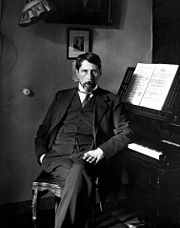Johan Wagenaar's Human Design Chart
1/3 Ego Manifested ManifestorDutch composer and organist.
Wagenaar evidenced a talent for music as a child. However, he did not begin to receive a formal education in music until age 13, with subsequent instruction in piano, organ, violin, theory, and composition. He was under the tutelage of the composer Richard Hol and the organist Samuel de Lange, Jr. In 1892, he studied with Brahms’ friend Heinrich von Herzogenberg in Berlin, specifically taking lessons in counterpoint.
In 1888, he succeeded Richard Hol as organist of Utrecht Cathedral, and earned fame for his skills at organ performances. In Utrecht, Wagenaar became a teacher at the music school in 1896, and the school’s director in 1904. He also received an appointment with the Utrecht Municipal Orchestra (Utrechtsch Stedelijk Orkest). Between 1919 and 1937, Wagenaar was director of the Royal Conservatory at the Hague.
Wagenaar’s compositions include operas, cantatas, organ music, and orchestral works. The music of Hector Berlioz had a modest influence on his works, but a much more pronounced influence was Richard Strauss.
In his later years, Wagenaar received an honorary Doctorate of Music from Utrecht University.
He died 17 June 1941.
Link to Wikipedia biography
Discover More Famous People
Browse and analyze over 55,000 public figures and celebrities.
Ra Uru Hu
5/1 Manifestor
Martha Stewart
4/6 Manifestor
David Lynch
4/6 Generator
Barack Obama
6/2 Projector
Steve Jobs
6/3 Generator
Vladimir Putin
5/1 Manifestor
Kim Kardashian
3/5 Generator
Michael Jackson
1/3 Projector
Marilyn Monroe
6/2 Projector
Ariana Grande
2/4 Projector
Oprah Winfrey
2/4 Generator
Johnny Depp
2/4 ManifestorWhat is HumanDesign.ai and how does it work?
Curious what makes Johan Wagenaar tick? HumanDesign.ai instantly maps their exact birth data into a fully interactive clickable bodygraph chart, letting you hover or tap every center, channel, and gate for plain-language explanations. Bella, the platform’s built-in AI guide, adds context in real time, translating complex mechanics into everyday insights so you can see how Johan Wagenaar’s strengths, challenges, and life themes play out on-screen.
The same tools are waiting for you. Generate your own Human Design Chart in seconds, open a library of 2000+ suggested questions, and chat with Bella as often as you like to decode your design, daily transits, and even relationship dynamics.
Want to compare energies? Save unlimited charts for friends, family, or clients, then ask Bella to reveal compatibilities, composite patterns, or coaching tips, all in one conversation thread.
Start free with core features, or unlock our Personal and Pro plans for deeper dives: unlimited Q&A, celebrity chart search spanning 55,000+ public figures, white-label PDF reports, branded content generation, and a professional profile with built-in booking for practitioners. Whether you’re exploring your own potential or guiding others, HumanDesign.ai delivers an ever-expanding toolbox of AI-powered insights—no spreadsheets, no jargon, just clarity at your fingertips.
Ready to see yours? Signup for FREE today!

